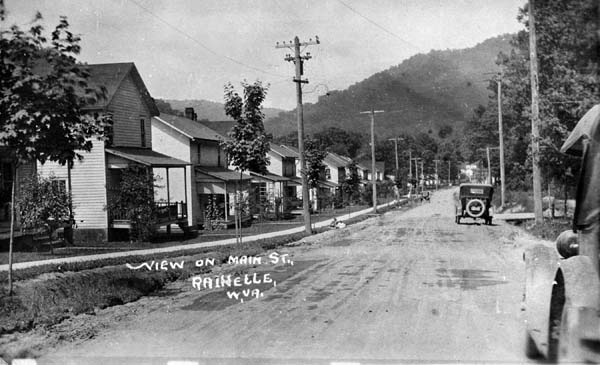Rainelle

Main Street in Rainelle, 1920s. Photo by H.R. Gray, courtesy of Meadow River Lumber Company Collection, the West Virginia Archives.
In Rainelle, all but one business and many homes were heavily damaged by the flood. Three weeks after the deluge, Rainelle Mayor Andrea Peterson was still searching for a silver lining about her hometown: “I’m trying to stay positive. We’re going to find a way to get through it. We’re a town built to survive.”
Rainelle has survived many times before—a fire that demolished the town’s band mill, floods, and the closing of the town’s once-prosperous lumber operations.
In its own way, Rainelle was as much of a company town as the coal camps of southern West Virginia. But, unlike many of those towns hastily thrown together by coal companies, Rainelle was built to last.
The story of Rainelle dates to 1906; although, James Coggin had built a grist mill in the area around 1790, and William McFarland had added the first saw mill in 1848. And it had long been a passageway on the James River and Kanawha Turnpike, which today, follows much of U.S. Route 60. And, in 1861, on nearby Sewell Mountain, Robert E. Lee first saw a sgrey American Saddlebred that would become his constant companion during the Civil War. He named him Traveller.
But the modern history of Rainelle really dates to 1906, when brothers John and Thomas W. Raine first started acquiring timber-rich lands in western Greenbrier County. When they arrived near the mouth of Sewell Creek. For four years, they bought up forest land and began building a mill and houses in the vicinity of an old chimney that once heated a turnpike tavern. Rainelle was chartered as a town in 1913.
Although it was built and owned by the Raines’ Meadow River Lumber Company, it developed dramatically differently than most coal company towns. Historian Otis Rice referred to Rainelle as a “model lumber town,” with “well-built white frame houses” that boasted modern features such as running water, bathrooms, and electricity.
The Raines brothers built a schoolhouse and supplemented teachers’ salaries to guarantee a full school term for students. They also built a company store, churches, a boarding house, and a theater—all made from the finest Meadow River products.
Significantly, Meadow River President Thomas W. Raine made his home in Rainelle. By contrast, most coal operators of the day lived in cities and town far separate from the workers they hired. This made Rainelle feel more like a big, extended family than a company-run town.
But Rainelle was far from a small town. The lumber operation was massive—in fact, the largest of its kind in the world. Meadow River cranked out a daily average of 110,000 board feet of lumber—some 20 miles per day. In 1928, the operation reached peak production, producing 31 million board feet of lumber in one year—theoretically, enough to build a wood-plank sidewalk from West Virginia to South America.
Meadow River’s main products were flooring and other building materials, but they also made a wide variety of products—ranging from coffin boards, to frames for Packard automobiles, to English submarine chasers, which were designed specifically to hunt down German submarines in World Wars I and II.
The company and town suffered a setback in 1924, when the mill burned down. But it was rebuilt the next year, and the work continued. The company fell into somewhat of a decline after World War II but still far outlived many of West Virginia’s smaller lumber towns that had long disappeared from the map. Another blow to Rainelle was the completion of Interstate 64, which bypassed Route 60 and the town in the 1960s.
Georgia-Pacific bought out the lumber operation in December 1970, ending the Meadow River Lumber Company’s more than six decades in business. Georgia-Pacific began shutting down the mill 17 months later and closed the operation for good 17 months later. Rainelle lives on, though, because of the quality of its structures and the residents’ love of their town. When Georgia-Pacific closed the business, it sold 80 of the original company houses to the families who had lived there for generations. So, in many ways, Rainelle is still very much a Meadow River Lumber Company town.
You can read the rest of this article in this issue of Goldenseal, available in bookstores, libraries or direct from Goldenseal.